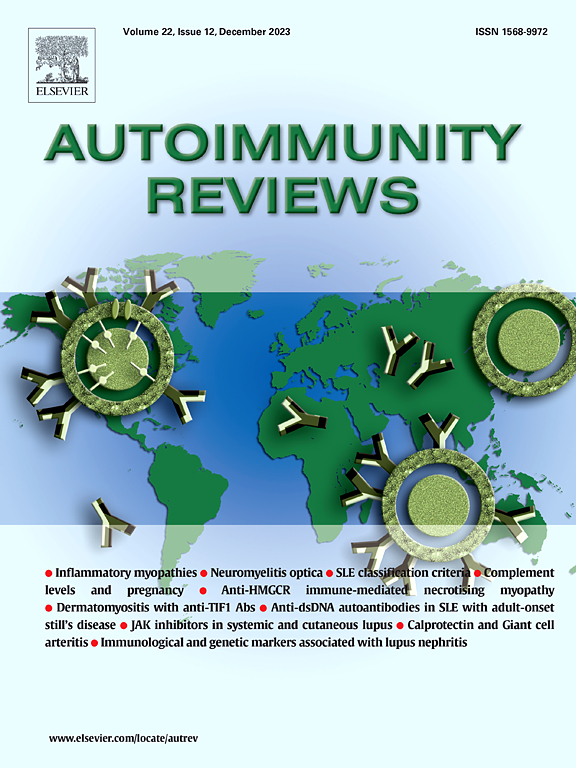衡量自身免疫性疾病负担的新标准及其在女性生命周期不同阶段的估计发病率。
IF 9.2
1区 医学
Q1 IMMUNOLOGY
引用次数: 0
摘要
目的:根据各种单一的自身免疫性疾病,建立一个独特的指标 "自身免疫性疾病(ADs)",并估算1990年至2019年女性生命周期各阶段的病例数和年龄标准化发病率,进一步探讨其在全球、地区和国家层面的时间趋势:方法:提出了妇女生命周期的综合分类。类风湿性关节炎、炎症性肠病、多发性硬化症、银屑病和 1 型糖尿病在所有年龄组(< 1、1-4、5-9、10-14、15-19、20-24、25-29、......、80-84、85-89、90-94、95+)的病例数和发病率的估计值和 95 % 的不确定性区间(UIs)均来自《2019 年全球疾病负担、伤害和风险因素研究》(GBD)。ADs "的定义综合了这五种疾病。采用直接法进行年龄标准化,以估算女性生命周期各阶段的 "ADs "年龄标准化发病率(ASR)。通过计算年度百分比变化(APC)和平均APC(AAPC),采用连接点回归分析法研究1990年至2019年ASR的时间趋势。此外,还探讨了 2019 年发病率以及 1990 年至 2019 年发病率变化与社会人口指数(SDI)的关联:结果:2019 年,全球儿童期、青少年期、成年期、老年期、育龄妇女期、围绝经期、更年期和最佳育龄期性成熟成人 "ADs "发病率的 ASR 分别为 45.46(95 % CI:36.40 至 55.09)、59.97(95 % CI:46.62至75.30)、104.45(95 % CI:84.55至127.79)、129.58(95 % CI:105.18至157.68)、89.51(95 % CI:71.94至110.35)、130.92(95 % CI:106.98至158.16)、132.94(95 % CI:108.76至160.90)和85.78(95 % CI:68.72至106.37)。从地区上看,虽然八个生命阶段的年均死亡率因不同的地理区域而异,但年均死亡率最高的前三位均出现在西欧、大洋洲和高收入的北美地区。各国自身免疫性疾病的发病率存在显著的异质性,社会人口发展水平越高,负担越重,这表明根据社会人口状况制定灵活的卫生政策和有针对性的资源分配对每个国家都至关重要。本文章由计算机程序翻译,如有差异,请以英文原文为准。
A novel metric of autoimmune disease burden and its estimated incidence across different stages in life cycle of women
Aim
To produce a unique metric ‘autoimmune disease (ADs)’ based on various single autoimmune disorder and estimate its case number and age-standardized rate of incidence for each stage in life cycle of women from 1990 to 2019, and to further explore their temporal trends at global, regional, and national levels.
Methods
A comprehensive classification for life cycle of women was proposed. The estimates and 95 % uncertainty intervals (UIs) for case number and rate of incidence for rheumatoid arthritis, inflammatory bowel disease, multiple sclerosis, psoriasis, and type 1 diabetes mellitus in all age groups (< 1, 1–4, 5–9, 10–14, 15–19, 20–24, 25–29, ……,80–84, 85–89, 90–94, 95+) were extracted from the Global Burden of Diseases, Injuries, and Risk Factors Study (GBD) 2019. ‘ADs’ was defined by combining these five disorders. Age standardization by direct method was utilized to estimate the age-standardized rate (ASR) of incidence of ‘ADs’ for each stage in life cycle of women. Joinpoint regression analysis was adopted to investigate temporal trends of ASR from 1990 to 2019 by calculating annual percentage change (APC) and average APC (AAPC). Associations of incidence in 2019 and change in incidence from 1990 to 2019, with Socio-demographic Index (SDI) were also explored.
Results
In 2019, global ASR of incidence of ‘ADs’ in childhood, adolescence, adulthood, senility, women of childbearing age, perimenopause, menopause, and sex mature adults at the best reproductive age were 45.46 (95 % CI: 36.40 to 55.09), 59.97(95 % CI:46.62 to 75.30), 104.45 (95 % CI: 84.55 to 127.79), 129.58 (95 % CI: 105.18 to 157.68), 89.51 (95 % CI: 71.94 to 110.35), 130.92 (95 % CI: 106.98 to 158.16), 132.94 (95 % CI: 108.76 to 160.90) and 85.78 (95 % CI: 68.72 to 106.37), respectively. Regionally, although ASR in eight life stages differed from distinct geographical areas, the top three highest ASR all occurred in Western Europe, Australasia, and High-income North America. From 1990 to 2019, global ASR in childhood (AAPC: −0.39, [95 % CI: −0.4 to −0.38], p < 0.001), adolescence (AAPC: −0.4, [95 % CI: −0.41 to −0.4], p < 0.001), adulthood (AAPC: −0.53, [95 % CI: −0.55 to −0.51], p < 0.001), senility (AAPC: −0.4, [95 % CI: −0.41 to −0.38], p < 0.001), women of childbearing age (AAPC: −0.53, [95 % CI: −0.55 to −0.5], p < 0.001), perimenopause (AAPC: −0.56, [95 % CI: −0.59 to −0.52], p < 0.001), menopause (AAPC: −0.56, [95 % CI: −0.59 to −0.53], p < 0.001), and sex mature adults at the best reproductive age (AAPC: −0.5, [95 % CI: −0.51 to −0.49], p < 0.001) all significantly decreased. Nationally, ASR and its temporal trends in eight life stages varied significantly across 204 countries and territories. Additionally, incidence in 2019 and change in incidence from 1990 to 2019 were positively correlated with SDI across nations.
Conclusions
Significant heterogeneities in incidence of autoimmune diseases across nations, with higher sociodemographic development level presenting higher burden, suggest that flexible health policy and targeted resource allocation tailored to sociodemographic status are crucial for each country.
求助全文
通过发布文献求助,成功后即可免费获取论文全文。
去求助
来源期刊

Autoimmunity reviews
医学-免疫学
CiteScore
24.70
自引率
4.40%
发文量
164
审稿时长
21 days
期刊介绍:
Autoimmunity Reviews is a publication that features up-to-date, structured reviews on various topics in the field of autoimmunity. These reviews are written by renowned experts and include demonstrative illustrations and tables. Each article will have a clear "take-home" message for readers.
The selection of articles is primarily done by the Editors-in-Chief, based on recommendations from the international Editorial Board. The topics covered in the articles span all areas of autoimmunology, aiming to bridge the gap between basic and clinical sciences.
In terms of content, the contributions in basic sciences delve into the pathophysiology and mechanisms of autoimmune disorders, as well as genomics and proteomics. On the other hand, clinical contributions focus on diseases related to autoimmunity, novel therapies, and clinical associations.
Autoimmunity Reviews is internationally recognized, and its articles are indexed and abstracted in prestigious databases such as PubMed/Medline, Science Citation Index Expanded, Biosciences Information Services, and Chemical Abstracts.
 求助内容:
求助内容: 应助结果提醒方式:
应助结果提醒方式:


